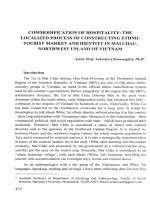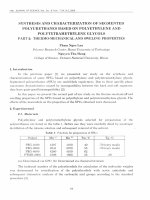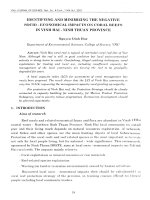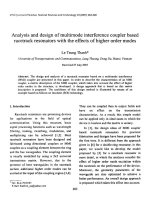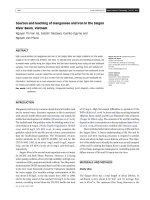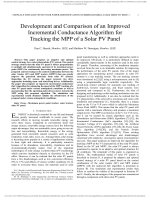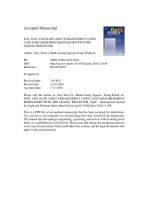DSpace at VNU: Identifying and minimizing the negative socio-economical impacts on coral in Vinh Hai - Ninh Thuan province
Bạn đang xem bản rút gọn của tài liệu. Xem và tải ngay bản đầy đủ của tài liệu tại đây (1.31 MB, 12 trang )
VNU JO U R NAL OF SC IEN C E, Nat . Sci , & Tech , T XIX, Nc1. 2003
II)E N T IF Y IN G A N I) M IN IM IZ IN G T H E N E G A T IV E
S O C IO - E C O N O M IC A L IM P A C T S O N C O R A L R E E F S
IN V IN H HAI - N IN H T H Ư A N P R O V IN C E
Nguyên Dinh Hoe
D e p a r t m e n t o f E n v i r o n m e n t a l S c i e n c e s , C o llc g e o f S c i e n c e , V N U
A s t r a c t : V in h H a i coral r e e f ís typ ical o f intcrtidcil co ra l r c e f Ịĩcit o f Viet
N a m . A lth o u g h th e r c e f is s ti l l in good co n d itio n bư t local socio-cconom ical
a c tiv ity is d o in g h a r m to corals. O verỊish in g , iỉlcgal c a tc h in g techn iq ues, coral
exploitation for tra d in g a n d local usc, in clu d in g irLsuffĩcicnt ca p a cit V for
m a rư igem ent o f thc local c o m m u n ity arc fo rc in g th e recf to bc g ra cỉu a lỉỵ
degradecl fo r years.
A local c a p a c ity in d e x (LCI) for a s s e s s m e n t o f coral m cincigcment hcis
new ỉy bccn proposed. The result shoivs th a t thc LC1 o f V in h H a i c o m m u n ỉ t y Ls
very low (0 314) rcq u cstìn g thc m ancigem cnt ca p a city need g r a d i n g u p urgcntly.
For pro tection o f V in h H a i rceft thc P rotection Strcitegy s h o u ld be closely
co nn cctcd to c a p a c ity b u il d in g for c o m m u n ity , fo r M a r in c P rodu ct P rotection
S u b a g cn cy , a n d to po vcrty rcducc p ro g ra m m cs. E c o to u r is m dcu elo p m c n t s /ìo u ỉd
bc p ỉ a n n c d expectantỉỵ.
1 . INTRODƯCTION
A im s o f r c se a rc h
Reef corals and relatecỉ economical fauna and flora are abuncỉant in Vimh i HHai
Coastal vvater - Northern Ninh Thuan Province. Ninh Hai local community Us ststítill
poor and their living much depends on natural resources exploitation, of vwhÌQÌoeh,
coral fishes and other species are the main hunting objects of local fishe>rmonoen.
Protection of the coral reeís and reef related species is the most important acctiv.vvitv
not only for local people living, but for national - vvide significance. This res^earircrch,
sponsored by Ninh Thuan DOSTE, aims at local socio - economical impacts om NNmnh
Hai coral reefs. The impacts mainly relate to:
- Coral exploitation as rnineral resources or ravv materials
- Reef*related species exploitation
- VVasting (on land or in marine environments) caused hy human activitiies
Discovered local socio - economical impacts then should be caiculaitedd 1 in
coral reef protection strategy of the province, in training courses offered teo lcloocal
people including local community leaders.
18
Td e n t ỉ f y ỉ n g (ĨÌKỈ m i n i ỉ f ỉ i z i n f ỉ t h c n c g a t i v e .
19
M et h o d o ỉo g y
PRA (Participatory Rapid Appraisal) is the most useĩul research tool in this
tase. For tha t usage, a question board has been careíully prepared for intcrview,
ittecỉ PRA methodology Ị1, 2]. 22 intervievvees havc hoen sèlecteci đuring a fiel(l
ỉheck bv rcsearcher in the end of September and the beginning C)f October this year.
im o n g them, 10 are local leaders and the others are local people but all of them an*
íshẹrmen or farmers. Beside interview, rẹsearcher has also made fielđ survey
tnroughout the Ninh Hai coast and discussed vvith some local experts in
tepartment of Kishery and DOSTE of Ninh Thuan, and with some local people in
tie nearby Tri Hai and Nhon Mai communes.
The question board afterwards has been analyseđ by SPSS technique. The
rsults of various intervievv techniques such as officialt semistructural, non-official
iiterviewt secondary data analvsis at last have been summed up into a set of
iidicators for assessment.
O v e r v i e i v o f V i n h H o i Coastal c o m m u n e
Vinh Hai is a C o a s t a l commune located in Northern C o a s t a l region of Ninh
Tiuan Province, dovvn to the South of Cam Ranh Bay. The Commune is inhabited
b’ 880 households with about 4500 people, accumulated in õ isolatc hamlets. Local
C c m m u n itie s c o n t a in tw o o th n ic g ro u p s : K in h (91% ) a n d R a g la y m in o r it v (9% ). T h e
la>t dwelled in Cau Gay and Da Hang hamlets, lived on agriculture and (orestry.
Knh people variously earned for living, but mainly by agriculture, fishor\- and
mirine product trnders (table 1 ).
T a b le 1. Ecơnomical systems in Vinh ỉ lai commune
N
Economical sectors
Simple Description
i.
Fishery
aquaculture
- Nearshore íĩshery, tho annual output is betvveen 100
and 1 Õ0 tons
9
Agriculture
and
- Cultivating: grape (30ha), rice, spice
- Grazing: about 2TÕ00 cattles (cow, goat, sheep)
3.
Forestry
- Forest replanting and non-timber exploitation in the
huffer zone of Nui Chua Natural Reservation
4.
Other economical
activities
- Small - scaleci trading: pesticides, marine Products
- Small - scaled íishes P rocessing: fishes dry-up, fish
sauce...
f
Tourism services: mainly at Vinh Hv and Thai An
hamlets
-
Nguyên D i n h Hlooíoe
20
Most of households are at the poor level, however, caused bv ecoxiomiccaaìal
growing-up among trading and lobster caging households, the rate of the poor in t:hh(he
commune is going dovvn by time (fig. 1 ).
Ytar
F ỉ g 1. Number
of poor
h o u se h o ld s
in 1999 - 2001
Almost the poor households are at Cau Gay, Da Hang and My Hoa hamlets.
2. IDENTIFYING THE NEGATIVE SOCIO-ECONOMICAL IM PACTS (O)NN
CORAL REEFS IN VINH HAI
2 .1 .
C u r r e n t s t a t u s a n d c h a n g e s o f c o ra l re e fs a n d r e e f
- re la te c l sp e c ie a ỉ ì iìin
p r e s e n t ti m e in N in h H a i
C o r a ỉ r e e fs i n N i n h H a i
Living corals inhabited in shallow water (from 4 to 10 m deep) in gcoooood
condition. Cover of living corals varies from 20% to 40%, being highest at Hang Ríaỉai
and Bai Nho. Dead corals take about < 10% in general, but highest at My Hoa ((cịca
15%). At locality, local human impacts have been recognizeđ such as blast or poÌỊsc;ojon
Hshing and coral cxploitation or mechanic destruction. A total of 197 reef»buildlim;ng
coral species have been điscoveređ at the site, of vvhich, at least 14 species are ne*wvlvly
recorded for Viet Nam, belonging to at least õ benthic communities (table 2)[3).
Table 2. Benthic communities of Ninh Hai coral reefs.
N°
Commu nities
Physical
% cover categorv/
1.
Dead stancỉing coral
Continuous pavement
1 - 10 %
9
Soft coral
Large blocks (diam. < lm)
11 - 30%
3.
Coralline algae
Small blocks (diam. < lm)
31 - 50%
4.
Turn algae
Rubble
51 - 70%
õ.
Macro algae
Sand
76 - 100%
My Hoa fringing reef is onc of few tvpical wide intertidal reef flat (ÕC)0> 1 m
width) in Viet Nam. In the other sites of Vinh Hai Coastal vvater, corals are smìa.all
I d c n tify in g a n d m ỉ n i m i z i n g th e ncgativc...
•>]
patc-hes on the sancỉv bottom between 2 to lOm depth and ranging U|) to soveral
hưndred m offshore.
Coral reefs in Vinh Hai are not only signiíìcant reservoir for coral
biodiversity, but reef-related species as vvell. A total of about 250 economic marinẹ
species have been reported by local fishermen, of which 14 fish, 5 shell-íìsh, 3 squicỉ,
3 crab species are highlv economical significant (table 3).
AU íishing boats of Vinh Hai are of low capacity (less than 45CV), íìtted only
to shallow water íìshing, so that these economical marine species are very
important to local living.
Coral exploitation has also been emploved bv local people since 1988 whcn
Phong Lan Company from HCMC hired local people to exploit corals (both dead and
living corals). This job started from then upto present although vvas prohibited
sơ me vears ago.
Table 3. Coraỉs and reef*related biodiversity of the shallow Coastal water of Vinh Hai [1]
N-
Taxonomy
1
Corals
2
Sca grass
3 spccics
3
Sca \vccds
24 spccics
4
Molluscs
9 spccics
5
Crustacean
3 spccies
6
Echinodcrm
2 spccics
Number of Species
197 spccies
Caused by overfishing (including blast, poison, overlighteđ and closelylinked net in the past) the marine biotic resources in Vinh Hai C o a s ta l shallovv
water have been degrading bv time.
Almost economic species have been little reduced;4 species much reduced
and only one species (Cá Mòi) is totallv disappeared. This direction clearly shovv
that the reef biodiversity is gradually degraded hy time of the last 5 years (1997 2002 ). However, the existence of Cua Huỳnh Đê (a reef crab), an indicator of
healthy reefs elucidates tha t the reefs of Vinh Hai are still in gooci reservation.
2 .2 . N e g a t i v e s o c i o - e c o n o m i c i r n p a c t s o n c o r a l r e e f s
C oral exp lo ita tio n
Coral exploitation started in Vinh Mai in 1998, vvhen Phong Lan Co. in ỉio
Chi Minh city bought corals from dredging activity. Some lcxal íìshermen exploited
also living corals outsidc the dredging lines to get high benefit. Number of coral
b o a ts in c rc a s e d f r o m 10 ( in 1998) to 30 (2 0 0 0 ) (ta b le 4)
9
9
M ềíé
Nguyen D i n h ữỉđóoe
Table 4. Illegal coral exploitations
Events
Year
1998
1999
2000
2001
Number of Violations
0
2ấm
ể
2
4
VVeigh
(tons)
0
8
4,13
11,7
0
6
mil.
Confiscated
all corals
15 mil. and
Coníiscated 9,7 tons
of
Fines (VND)
corals
20022
ì
-----------J
N^O d;attaa
p
1
someĩ
tons (#*)
Source: Departm ent of Plshery. Ninh Thu.an (6>/2Q0C!X)2)
(•) data fro»m int(ervviview
Corals were also exploited as ravv materials for Phuong Hai cement fac:tcoDry
and some small-scaled lime kilns. In rough estimation, 1000 ha of shrimp poncdss ] in
Ninh Thuan consumed 500 tons of lime per year. Many years ago, the lime lkiihlns
used both dead and living corals as raw materials. In 2002 , the lime prodiucceers
bought mostlv deacl corals from Cam Ranh, because the exploitation and tradimgg ' of
living corals has been strictly prohibited in Ninh Thuan. Hovvever, some vủolattkonns
for trading living corals may still existed in the region (table 5).
Table 5. Results of Intervievv
Question
Answer (rate of answer)
1 . Is there still coral exploitation in present
ti me ?
- Yes (44.4 %)
2. Number of local coral exploiters ?
* just a few (22 .2 %)
“■
..........
- Sell to Phuong Hai cement pllannt
(56%)
3. Purpose of coral exploitation
- No (55.6 %)
- Sell to IICMC (22%)
ị. VVeigh of corals cxploited
- Some tons (16.7%)
- A little (11.1%)
- ưnknovvn ( 1 1 . 1 %)
R e e f - r e la te d reso u rces e x p lo ita tio n
Reef related resources are clearly recognized by local people, it c:an be
conTirmed that almost local dwellers reliecỉ upon these resources for liiwi’ing
Therefơre, many illegal catching techmques are still used, this is the nrmost
important reason of coral reef degradation (table 6).
93
Idcntỉfying a n d Iììiìiiĩniziĩiịị the ncgativc...
T a b h ‘ 6 . Violating vvays and tools for fishing
Violating ways and tools
1 . Overfishing
2. Blasting
Conĩirmation by local vvitnesses (rate of answer)
- Yes (61.7%)
- Com mon (33.3%)
* Sometimes (22 . 2 %)
3. Electric stimulating
• Sometimes (16.7%)
4. Poisoning
- Sometimes (27.8%)
õ. Closelv linkecỉ net
- Yes ( 1 1 . 1 %)
Overíĩshing, blasting and poisoning are the main illegal activities, that
negatively affected to coral environment. Local witnesses also confirmecỉ that
violated fishermen are mainly outsiciers (írom other provinces, and from South Ninh
Thuan region such as Dong * Ba - Hai - Chu) (table 7).
Table 7. Where did the illegal fishermen come from?
Locality of illegal fishermen
1 . Outsiders?
2. Local dwellers?
3. Where did the outsiders come from
Rate of ansvver/confirmation
. Yes (83.3%)
- Yes ( 1 1 . 1 %)
- Mainly from Khanh Hoa province and
South Ninh Thuan fish villages.
M a r in e P o llu tio n
There are 2 types of marine pollution being recorded by local fishermen: the
lst is land-based, the 2 ntl is rnarine non-identified
L a n d - b a s e d p o llu tio n so u rce s related to production and living wastes.
AU rubbish of the community is put into the sea. In average of 0.5 kg per capita per
iay, the average of daily rubbish is about 2.3 tons. The main part of the vvastes is
Drganic vvastes, hovvever, some toxic wastes have also been discoveređ in various
dumpsites on the sea shore such as batteries, pesticide bottles, oozy metals etc.
27.8% of the ansvvers agreed that pesticides used on the farms are leached to the
sea and did harm to coral biota. 33.3% of interviewees reported that they met
pesticide bơttles in the see, 50% the answer confirmed that rubbish is đangerous
sources to the marine life. Hereunder is the list of land-banđ sources that local
people believe to do harm to coral biota (table 8)
Table 8 . Land-based pollution sources
The sources
Rate of confirmation by answers
]. Ship building factory
- yes 5,6%
i. Aquaculturc (shrimp ponđs)
- yes 1 1 ,2 %
í Fish harbour Khanh Hoi
- yes 5,6%
4 Fish Drv stations
- yes 5,6%
5 Army harbour
- yes 5,6%
Nguy en Dinh Hoe
24
M a rin e non
- id e n tifie d p o llu tio n source
38.4% intervievvees reported that they met oil pollution on the coral vvater, off
vvhich, 5.6% said the met very often. Red tides are also met by fishermen, 44.4% otr
the ansvvers confinned that they met red tides in summer time (between April to
»Julv, yearly). Many times (55.6% answers) they met a lot of đead fishes but they didl
not knovv about the reason. During rainy seasons, seawater turn muddy caused hy*
s e rio u s e ro sio n som evvhere on land .
[t is noteworthy that there is totally not any industrial sites onshore thaĩt
may produce red tide over the sea. Some fishermen thought that the red tides may
caused by vvaste vvater from Dam Nai shrimp field. About oil film, the fishermen
explained that related to marine transportation in and out of Cam Ranh Bay.
Sometime, fishermen met accumulations of cianur (CN) bottles Aoating on
the water, these bottles may be dropped out by some illegal coral fis lì catching hy
unknovvn people, whom they believe to be outsiders;
Reasons o f negative socio
-
economic im pacts on coral reefs
- Community insufficient awareness
Within the framework of the programme "Sea Turtle Preservation", s o m e
traiiỉing courses and environmental communication were offered to local community
about the role of coral reefs; violations to corals are gradually reduced by time. In
2002 , it can be said that most of violations has been controlled successíully.
Hovvever, t.he people awareness about the coral reef values is still poor.
There is sũll a lot of people does not have knowledge enough about coral values
(table 9)
T a b l e 9. Insufficient knowledge about coral values
------------------------------------- Ặ - ---— —
I
Issues
1 . Corals are useful people living
2. Coral reefs are an important habitats
of economic species
3. Coral reeís are good barrier to prevent
wave attack, to protect the sea shore
4 Coralline rock are useful
5. Corals are good for scientiíĩc research
6 . Coral habitat are gcx)d for tourism,
attachcd a lot of tourists to come.
7 Corals are sensitive species that are
easily to dye caused even by small scaled change of environment
Rate of answers
- Never think about that (5-6%) (ngroed:
94.4%)
- No, false! (5.6%) (agreed: 94.4%)
- No, it is not true! (44.4%) (agreed:
50%)
- No, it is not true! (70.6%) (agreed
27.8%).
. False! (72.2%) (agreed: 22.2%)
• False! (66.7%) (agreed: 27.8%)
- Do not agreed! (38.9%) (agreed: 38.9%)
• Never think about that! (22 .2 %)
Idcìit ifyiìiị* a n d m i n i m i z ì t i g t h e n e g a t ỉ v c .
25
The above table shows that people vvell understand coral recf b e in g habitats
of economic species (only 5.6% interviewees opposed). The remaineđ 6 vnluable
issues are opposed hy most of answers. It is casily understand that why illegíil
activities still oxist in the conimune.
P o ve rty
Povertv is still dominating Vinh liai Commune. There are 12% households
are uncler povertv lino. This issue is the main barrier of coral reef protection.
/ uncierstand t h a i co ra l rccts n e e d !() be protecteci Huĩ ỉ/ íherc ỈS
o n e \vho hirc m e to expỉoit livmg corals \\ỉíh high pơym cnt. / \\ ill
diì Aí íhc p rc se n í rate. onc coral com m uruty w e ig h e d o f( ) 5ki>
e q u a ỉs to 3ki> ()f rice' / havc to fc cd m v c h ild r e n 1
O ne iìsherm an at M x H o a h a m le t
/ ha vc to cìo a loí o fth iM Ị to gcỉ money. to supp ort m y
/ h avc
no IIme to kno\\' a n d to learn ab out corals
O ne [arm cr a í Thu ì A n h a m le í
This explains vvhile over fishing and illegal catching tools still being used in
the com mu ne.
ỉnsuỊỴicicnt m anagcm ent vapacity
T a b l e 10. Avvareness on legislative document
N'
Na me of document
Rate of "UnknownH !
answers
1
All 7 (iocurnents
2
Ordinance
of
(Governmental)
93.93%
(only 0,61% knevv)
72.2%
3
Decree 48 CP of Government on executive fining
violations in aqua-resource protection and development
Circular 01/200/TT-BTS guiding the application of the
Ordinance 1989
Official Dispatch 572/KT(1999) of Ninh Thuan PC on
preventing illegal coral trade
4
5
6
7
8
aquaresource
protection,
1989
88.9%
94.4%
94.4%
Resolution 20/2000/CT of the President of Ninh Thuan
PC on up grading coral resource management
Official Dispatch 30/CV/TS (1999) of Ninh Thuan
Department of Fishery (DOF) on coral exploitation at
Son Hai coast
88.9%
Official Dispatch to CV/TS (1999) of Ninh Thuan DOF
on upgrading control of coral exploitation
77.8%
100 %
N guỵen D in h Hoieìe
26
The most important issue is that just a few communal leader (ex: president oor>r
high ranking leaders of the commune) knew about 7 legislative documents dealimgtg
vvith marine Products, and almost local people knows nothing about thessese
documents (table 10 ).
It is concluđed that almost local leaders and people knew nothing abovutut
legal framework of marine P r o d u c t s , including corals. How can the community anidid
its leaders rríanage their coral resources?
The provincial Subagency for Marine Product Protection is poorlv equippeecbd
(lacking enough manpower, budget, equipment). The capacity of Subagency is far ttcto
reach its responsibility.
The m s p e c t bo a t IS larạe but p o o rỉy equippeđ, w h en ev er it sa ils o u t to
the seo, vĩolenỉ boaís well kn ou a n d h ave en o u g h ti m e to sai! a w a v
s a fe ly - violent b oats are sm a ỉler hut m ore pow erfnl, íhey can g e í to the
s h o r e ỉ f ca n noi run away. m e a n u h ile the ỉnspect b o a t c o n
to
F isherm en in Vinh H y a n d Thúi A n
Lx>cal people vvell know where the illegal boats come from and what illegal catchirnpig
tools they used, but thev have no respoưsibility and right to arrest violent boats.
P o o rly p c irtic ip a to ry c o m m u n i t y
There are 7 steps of participation, from bottom up to top., hovvever, tlhhe
participation of Vinh Hai community in to coral reef management is still poor (taholole
1 1 ) according to interviewees, during in the previous projects.
T ab le 1 1 . Level of participation
Level of participation
Participator>’ steps
Not participatory
(ÌOOIỈ p articipatco rarv
1 . Be invited to join meetings but no role
66.7%
27.8% (0,27?8 8 )
2. Be iníbrmed what should be done
55.6%
38.9% (0,39)88)
3. Be intervievved by project experts
2 2 .2 %
72.2% (0,7222 2 )
4. Participated in project for receiving something
(ex. money, tools...)
77.8%
16.7% (0,16)7 7)
5. Participated
something)
(done
61.1%
33.3% (0,33ì3 3)
6 . Discussed vvith project leaders, participated in
action plans, decision making
66.7%
27.8% (0.2"7S8)
7. Formulated local initiatives, projects and
r.arried out than vvith supports from outsiders
88.9%
5.6% (0,05>66)
in
project
practice
ldentifying and mitìimizing the ncgative..
27
3. PR OPOSED INDEX FOR ASSESSMENT OF LOCAL CAPACITY IN
CORAL R E E F PR O T E C T IO N
Local Capacity Index (LCI) can be calculated bv 3 indicators as íòllovved'
LCI = (I, + I. + I ;)/3
I ị-, m e a n r a te o f local avvnreness on coral r e e f v a lu e s (7 is s u e s , ta b le 9)
I : m e a n r a te o f local u n d e r s ta n d on legal fram ew ork (7 d o c u m e n ts , ta b le 10)
I •: c o m m u n itv p a r tic ip a tio n lev el in coral protection (7 s te p s , ta b le 11)
In Vinh Hai case stuciy, the Ị indicators are as following:
I, = (0 .94 4 + 0 .9 4 4 + 0 .5 0 + 0 .2 7 8 + 0 .2 2 2 + 0 .2 7 8 + 0 .3 8 9 )/7
= 0 .5 0 7
I_ = 1- (0.722 + 0.889 + 0.944 + 0.944 + 0.889 + 1.000 + 0.778)/7
= 0.119
I, = (0 .2 7 8 + 0 .3 8 9 + 0 .7 2 2 + 0 .1 6 7 + 0 .3 3 3 + 0 .2 7 8 + 0 .0 5 6 )/7
= 0 .3 1 7
L C I = (0 .5 0 7 + 0 . 1 1 9 + 0 . 3 1 7 ) / 3 = 0 . 3 1 4
Category of LCI:
0.00 -> < 0.40 : lovv capacity
0.40
< 0.60 : problem
0 .6 0 -> < 0 .8 0 : good c ap a city
0 80
< 1 . 0 0 : e x ce lle n t cap acity
I X I of N in h Hai c o m m u n itv is 0 .3 1 4 , b ein g in very low c a p a c ity .
4. CONCLUSION AND SOLUTION
4.1. C on clusio n
- V in h Hai coral r e e fs are sig n ific a n t reserv oir for coral biodiversity and
typical intertidal reef flat in Viet Nam. The coral reefs here are highly useful for
scientiíic research, ecotourism development, biodiversity conservation and
important marine resources for local people living. By all prices, the reefs should be
protected for present and future generations.
- Cause bvoverfishing and use of illegal catching techniques foryears, coral
reefs and reef related species in Vinh Hai gradually degraded, although the current
status of the reefs is still in good condition. Accorcling to the local witnesses, marine
p o llu tio n in c lu d in g oi 1 s p ills , red tid es, vvastes, dea d rifih a c c u m u la t io n s , ille g a l
coral exploitation for trading to HCMC and for lime kilns etc... have been recorded
by tim e. T h ese e v e n t s on t h e o n e han d, reflect la n đ - b a se d p o llu tio n s o u r c e s a n d on
the other, relates to non-icỉentifiecỉ pollution origins.
Ntfuyen Dinh Hoc
28
- Up to present tim e, local community u n d e rsto o d somevvhat of coral reefs, but
th o a w a r e n e s s be s till lo w -lev eled . L ack ing knovvledge o f legal fram ew ork o n o u g h ,
with low capacity for reef management and no vvay to control the íìshing boats of
the other regions coming and using illegal methods to exploit the marine Products
(including blast, poison, living coral collection etc...), local people striving for reef
protection seems to be unsuccessíul, if not to be in despair.
4.2. S o l u t i o n
- The highly urgent solution is grading - up the LCI by: offering training
c o u r s e s and c o m m u n ic a tio n to local c o m m u n itv not only V in h H ai b u t o th er fis h in g
communes in the province as well, dealing vvith awareness on coral values, legal
framework and participatory approach.
- C o n n e c tin g th e s tr a te g y o f coral protection to poverty red uce prog ram m es
(approvement of the buffer zone economy by ecotourism development, and other
suitable economical programmes).
- C ap a city b u ild in g - up for M arin e Product Protection S u b a g e n c y o f th e
province, enough to vvell running its responsibility, establishing some marine
p ro d u ct pro tectio n o r g a n iz a tio n o f co m m u n ity - lev el. T h e se groups sh o u lđ well
coordirm te w ith th e S u b a g e n c y .
REFERENCES
1.
GTZ. P a r t i c i p a t o r y I c a r n in g a p p ro a c h e s: rapicl rurcil a p p r a is a l, p a r tìc ip a to r y
a p p r a i s a l , V erla g, G e rm a n y , 199Õ.
2.
T hir,
J.
and
H .M .
G ray,
P a r tic ip a to r y
rcipid
a p p ra isa l
for
c o m m u n it\
d c v e l o p m e n t, IIE D . London, UK , 1991.
3.
V a n tie r D, R e e f b u i l d i n g c o r a ỉs o f N in h T h u a n Prouince, S ou th Central Viet
N a m , R apid E cological A s s e s s m e n t , Report p rep a red for W W F, 2002.
4.
O v e r v ie tv on le g a l f r a m e w o r k a n d m a n a g e m e n t o f co ra l reefs in N inh T h u a n ,
N in h T h u a n D O F , 6 /20 0 2.
ĩ d c n t i f y ỉ n t f a n d tn in im iz itiỊ Ị th e n c g a tiv c ...
TAP CHỈ KHOA HOC ĐHQGHN. KHTN &CN T XIX, N01.2QQ3
X Á C Đ ỊN H V Ả G IẢ M T H lỂ ư T Ấ C D Ộ N G T IÊ U c ự c
CỦA H O Ạ T Đ Ộ N G KINH T Ế XẢ HỘI
L Ê N RẠN SAN H Ò ở VỈNH HẢI - T Ỉ N H NINH T H U Ậ N
Nguyễn Đình Hoè
K h o a MỎI trường, Đ ại học K hoa học Tự nhiên, D H Q G H á N ộ i
Ran s a n hô ở V ĩnh H ải th uộc loại điên hình cho kiêu rạn p h an g v ù n g tr iề u cua
V iệ t N am . M ặc dù rạn còn được bảo tồn tốt n h ư n g h o ạt đ ộ n g kinh tê * xà hội d an g
gây hại c h o rạn. Đ á n h bắt q u á mức, sử dụ ng kỹ th u ậ t đ á n h bắt huý d iệt, khai thác:
đá sa n hô đê bán hoặc sử d u n g tại địa phương, c ù n g vói n ă n g lực q u ả n lý ch ư a đu
đáp ứng c ủ a cộ n g đồng địa phương trong n h iều n ố m qua đ a n g d ẫn r ạ n s a n hô dến
su y thoái.
Chỉ sô N ă n g lực Đ ịa phương (LCI) d ù n g cho đán h giá khả n ă n g q u ả n lý rạn
san hó lần đầu (lược đẻ xuất. Kêt quả cho thấy LCI cúa cộng đồng Vĩnh Hải rất thấp
(0,314), đòi hỏi n ă n g lực q u ả n lý phải n h anh chóng được cải th iện .
Đô bảo v ệ rạn san hô V ĩnh H ải, C h iến lược Bảo vệ phải gắn c h ặ t vối v iệc tă n g
cường n ă n g lực cho cộng đồn g địa phương, cho Chi cục Bảo v ệ N g u ồ n lợi T h u ỷ sản,
và g ắn k ết với các chư ơng trìn h xoá đói giảm ngh èo. P h át triển du lịch s in h th ái
c ũ n g cần được dưa vào quy hoạch.

